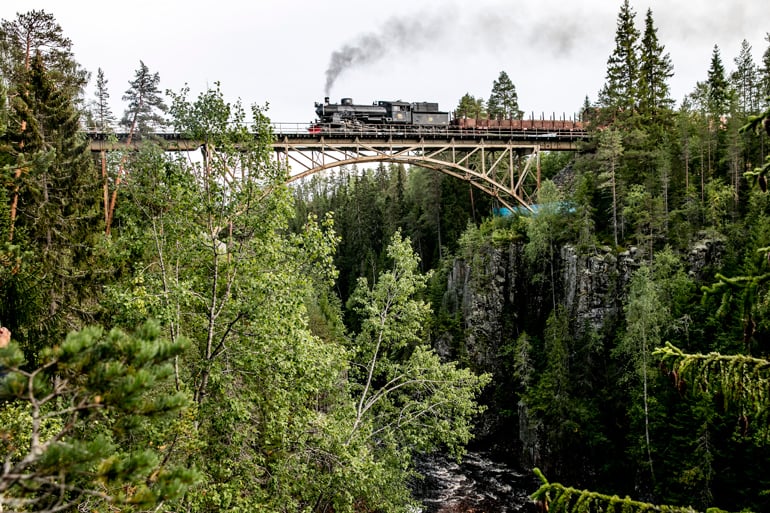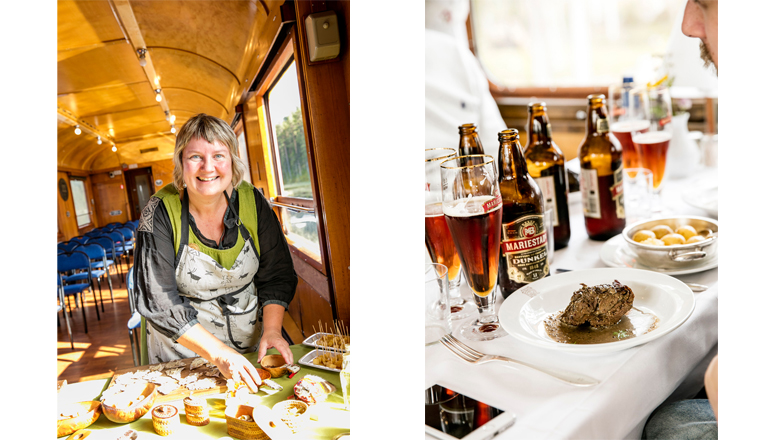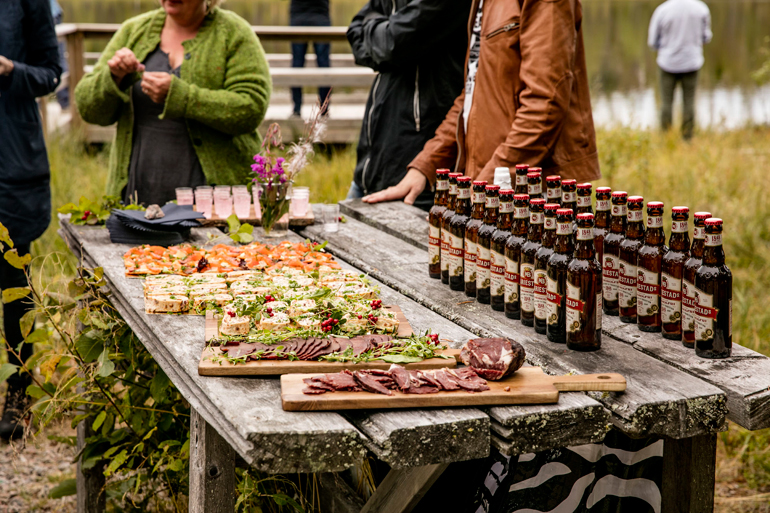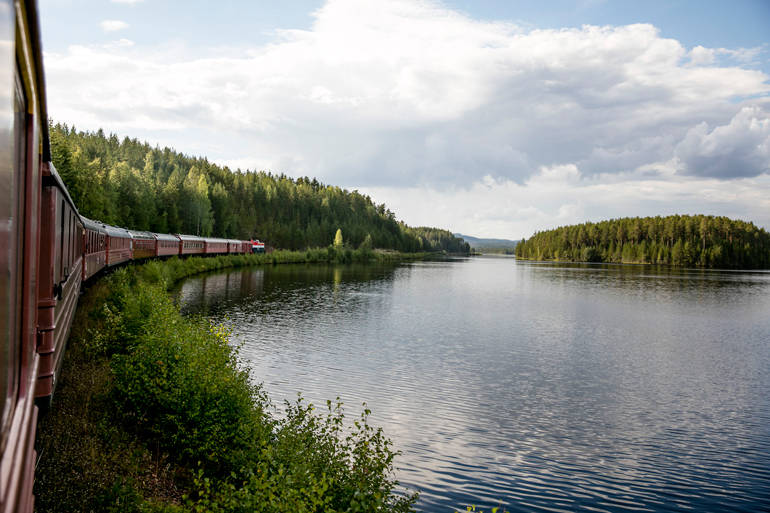Start 14-Day Trial Subscription
*No credit card required

The Great Taste Adventure of Swedish Beer
Sweden is exactly the kind of place where you could imagine fairies flitting flower to flower, or mountains and streams speaking to you in whispers and grumbles. It’s the kind of place of where you may trip over an obstruction in a forest pathway only to realize it’s actually a Viking longsword.
Whether in the bustling southern region where Stockholm, and more than seven million of the country’s ten million total inhabitants are located, or the old rustic North, it all feels like hallowed ground. And it is, in a way. Swedish common law of allemansrätten dictates that all men and women have the constitutional right to legally wander land, whether public or private. Of course this excludes criminal or otherwise destructive activity, but the result is a country that treasures all of its land, and the difference is noticeable.
What’s this have to do with beer? In a stroke of divine provenance, The Beer Connoisseur was contacted by Mariestads Brygerri, a prominent Swedish brewery, to take part in its Den Stora Smakresan, which translates to “The Great Taste Adventure.” Perhaps due to Swedish ancestry, I answered the call and was treated to an eye-opening, life-changing adventure.
The philosophy behind Den Stora Smakresan was that of inspiration, born of the land or sea. In true Swedish fashion, Mariestads brewmaster Richard Bengtsson would utilize knowledge and ingredients gathered on the trip to formulate a recipe for a special limited-edition series of beers. In the past, he brewed a channel-porter, inspired by what sailors navigating the country’s canals may have indulged in, resulting in a dry, savory and full-bodied porter with notes of coffee, chocolate and licorice, along with a Swedish oak-aged DIPA and a robust smoked beer.
This round, the result was a California Common, or steam beer, and fittingly, the trip took place on a more than one-hundred year old steam-powered locomotive, laboriously restored to its original glory with millions of dollars worth of Swedish taxpayers’ money, along with the railway it would ride on.

The Great Taste Adventure would inspire brewer Richard Bengttson to produce a California Common, also known as a steam beer.
Though the Swedes are heavily taxed as it is (resulting in universal health care, amongst other state-sponsored programs), they don’t mind. They enjoy one of the highest qualities of living anywhere in the world, and they understand the monetary sacrifice required.
I was to join the trip for two of its four days. But first, I had to get to Sweden.
If you’ve never been on a transcontinental flight, you may be shocked to find out that it’s not terribly unpleasant. I can’t vouch for all airlines, but Delta had both decent quality food, and unlimited, free on-demand programming. Leaving from Atlanta, I had a layover in New York before beginning the roughly nine-hour flight, kept company only by travel guru Rick Steves’ guidebook to Scandinavia.
As a newbie to international travel, I was quite lucky to be traveling to an American-friendly country – over 90 percent of Swedes speak English, as they’re taught it in school, and they’re happy to speak it. That being said, it seems to be a general rule that the more effort you put in to speaking, or in my case, mangling a few phrases at minimum, the more enthusiastic response you’ll get. It’s worth mentioning, because in the case of the train trip, I was the only American on board.
But before embarking on the Great Taste Adventure, I would spend a night in Stockholm, which aside from being Sweden’s capital, is considered one of Europe’s preeminent cities. And before making it to Stockholm, I had to take a bus from Arlanda International Airport, which is about 40 minutes outside of the city.
The adrenaline coursing through my veins at the prospect of venturing outside my previously unbroken bubble of Americana bested my jetlag, and the overcast early morning gray of the sky did nothing to quell the awe at the uniform beauty of the landscape. The simplest of roadsides in Sweden will be clean, and dotted with moss-covered glacial boulders and pines.
Seagulls and seabreeze heralded my arrival in Stockholm, and with a quick five-minute stroll from Centralstation, the city’s hub, I was home for the night. Even after five minutes, you can tell that it’s a city with centuries of history around every bend, and also, that they really enjoy the food of other cultures.
Believe it or not, it’s easier to find Thai food, or kebabs, than authentic Swedish cuisine. The most obvious reason is that Sweden has been quite permissive when it comes to immigration, and as a result, around 20 percent of Swedes come from elsewhere – places like Finland, Iraq, Iran, Poland, Somalia and Bosnia. Often, places of strife.
These populations are concentrated in metropolitan areas, making for a more heterogeneous cultural experience that one might expect. Perhaps as a result, or maybe because it’s just how the Swedes are, they also have a natural fascination and appreciation of other cultures in a way that Americans don’t.
What may be seen as antiquated symbols of America to us, like Elvis and especially Brooklyn, are all the rage. Yankees caps abound, Brooklyn beer enjoys prominence, and many Swedes expressed their heartfelt desire to visit Graceland.
But mistaking this sort of cultural difference for naivete would be misguided at best – these are highly educated and tolerant people with much to offer.
So, after getting some much needed rest in Stockholm, it was back to the train station to catch a bus to Leksand, a few hours north. From here, I would meet up with the rest of the party to join the train, which had begun its journey the day prior, snaking its way up from the southern coastal region and eventually within a few dozen miles of the Arctic circle.
The geographic diversity of Sweden is also astounding. The country is roughly the size of California, but you can find mountains and tundra in the north and west, and where there isn’t snow or rock, lush forests straight out of a Tolkien fantasy and azure lakes which perfectly mirror the sky greet you.
Arriving at a quaint local train station, our party was greeted by the conductor, Henrik Reuterdahl, who looked just as you’d imagine a conductor to look. While his crew refilled the steam engine with a water hose, he briefed the party on basic train safety and etiquette. As the only non-Swede, I couldn’t understand a lick of it, but as is the norm for Swedes, he was happy to give me the basics – the most important being that if you want pictures, don’t climb on the tracks to do so. The desire to not be run over by a locomotive seems to be universal.

The authentic steam locomotive would stop over lakes and rivers, allowing the crew to use a hose to suck up water for its engine.
The first order of business was beer, the first of which was brilliantly crisp and well-attenuated Export Lager, the company’s top-seller. Interestingly, the “macro vs. craft” dynamic is decidedly different in Sweden. Mariestads is one of the country’s largest brewers, and as such, is considered by some to be “macro.” And there are certain hallmarks – they enjoy a firm grasp of taps and shelf space in the country’s state run, monopolized “systembolaget” liquor stores, which are an experience in themselves, yet the company is still smaller than many of America’s top craft brewers like Sierra Nevada or New Belgium.
And though you may get a range of responses when you ask locals what they think of “bigger beer,” Mariestads brews dozens of styles, from lager to kriek, in an eco-friendly manner. In 2016, the company opened a new biofuel plant, allowing its brewery to operate solely on renewable energy, and its brewmaster Richard Bengtsson spent over a decade studying under top Bavarian brewers before returning to Sweden to start a brewing career.
All this, and we haven’t even made it to lunch.
Each day, breakfast lunch and dinner were cooked by the winners of what is essentially Swedish Top Chef. The dishes they produced were nothing short of spectacular, and in at least one case, wouldn’t even be legal in the U.S.
That meal was bear, and it tastes like rich, savory roast beef, and blends wonderfully with the Mariestads porter. The way that bear and beer are pronounced by Swedes in English are very similar, so it took a few bites before even realizing I was eating a rare piece of meat. According to various sources on the trip, between 200 and 600 bears are taken annually in Sweden, as they are far less endangered in Scandinavia than in the U.S.

Amongst the great tastes on this adventure: flowers sourced from within the Arctic Circle, reindeer, moose and even bear.
Many Swedes themselves had never had bear (bjorn in Swedish), before. However, they were quite familiar with beautifully plated reindeer, moose and a rainbow assortment of opalescent caviar dishes, most notably from arctic shark, which looked like tiny pearls on the plate.
As we journeyed increasingly northward, we would stop over rivers in order to refuel. The locomotive crew would dip a hose into the water to suck up more water, while the passengers sipped various Mariestads offerings. The Swedes have a natural propensity for lagers and pilsners, though my trip to the state run liquor store, which is the only place you can get beer above 3.5 percent, did reveal five or six craft brewers, who seemed to favor IPAs with local, often organic ingredients. I was also happy to see a solid amount of American brewers represented such as Green Flash, Terrapin and Old Coast.
At one point we stopped for a fun round of simulated bear and moose hunting, with authentic-feeling weaponry hooked up to a laser system to show whether or not you’d hit your target. While this may sound a little odd, there is actually a reasonable concern for Swedes, especially in the northern half of the country, to be on the lookout for bears. Much of the north is wild, making for gorgeous scenery, and better breeding for large, dangerous critters.
Had I not been exhausted from non-stop travel and beer consumption, I would have been game for a fun night with the rest of the passengers. Swedes can hold their booze. As soon as dinner ended, we switched from beer to coffee (kaffe), and straight to a cask of rum. Swedes are also some of the largest coffee consumers per capita in the world, which may have been why they were able to party until four in the morning, wake up at eight, and still look better than me.
Upon waking, I found out that I had not only missed a midnight bath in a frigid lake, but I’d also missed the aurora borealis, which had crept into the night sky around 1 AM, in the five or six-hour span where the sun wasn’t shining.
Day two was similar to the first – a constant whirlwind of admiration for how universally cultured my native fellows were, and how copious and delicious the food and drink was. Generosity was a given, as were patient explanations of the itinerary, which was always a bit of a mystery to me. I disembarked in Ostersund, roughly the same latitude as Southern Alaska and Iceland.

Nicklas Jonasson (left), head brewer Richard Bengttson (right) and myself revel in the heavenly weather, which was as clear and golden as the beer.
Not once had we passed an inhabited area that was anything more than passingly developed, and never in a way that insulted the land. Little things were different, but they were always well thought out – in a hotel, you activate the lights by placing your key card in a slot. That way, you never leave the room without it, and you never leave the lights on when you’re not there.
Applying principles learned from a country 1/30th the size of America is easier said than done, but if as much thought was given to pedestrian traffic, green living and day-to-day living as is in Scandinavia, we’d be living in a different, and likely better America.
You don’t need me or any other sandy-haired pundit telling you what America needs to be great, because it is. However, in beer and in life, everyone benefits from experiencing something completely out of their element. And what they take with them becomes the seed for something completely new.
From Den Stora Smakresan, I gained a different take on what really matters in life. The richness one gains standing on the edge of a roaring waterfall carving its way through a cliffside is likely going to mean more than a day’s pay ever will.
Mariestads Brewmaster Richard Bengtsson gathered what he needed to craft a beer he’d never brewed – one simultaneously inspired by his homeland, and the precedent set by brewers like San Francisco’s Anchor, which he’d visited to learn more about the California Common style.
Whether you try a new beer, or drink in a different horizon, I urge you to go on your own great taste adventure.

A Lapplander, or northern Swede, provided authentically sourced fare to be paired with the beer, including hand pressed elderflower lemonade and homemade smoked reindeer jerky.



